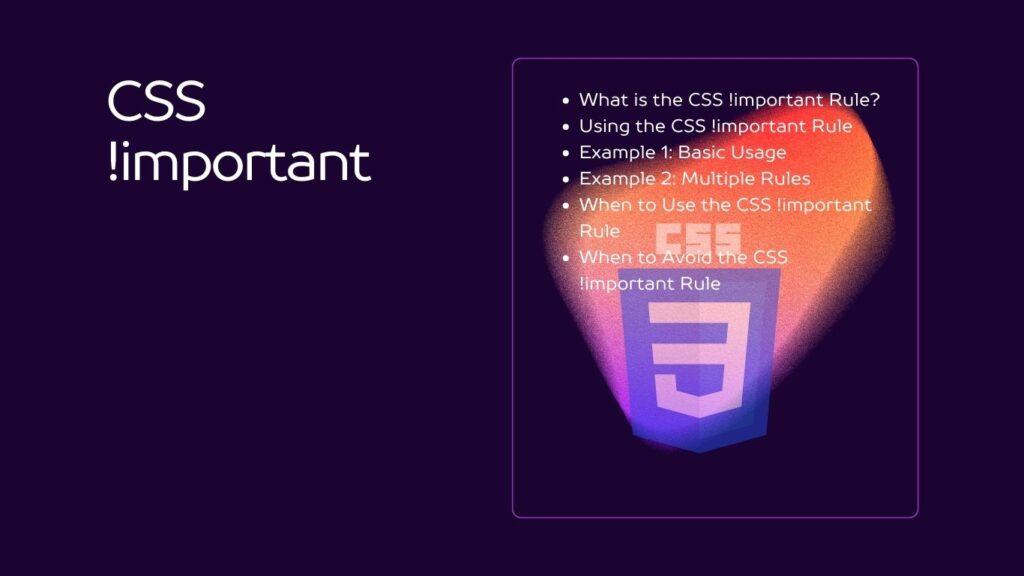Welcome to our comprehensive guide on CSS !important, a crucial concept in the world of web development. In the ever-evolving landscape of web design, the CSS !important rule serves as a powerful ally for developers seeking to exert absolute control over their website’s styles. With this rule at your disposal, you’ll have the means to ensure that your chosen styles take precedence, regardless of the complexity of your CSS codebase. In this article, we’ll demystify the !important rule, providing you with a firm understanding of when and how to wield this tool effectively.
As you delve deeper into this article, you’ll discover practical examples and insights into the usage of !important in various scenarios. We’ll explore when to employ this rule as a solution to styling conflicts, as well as when it’s best to opt for alternative methods of specificity. Whether you’re a seasoned developer looking to fine-tune your CSS skills or a beginner eager to gain a deeper understanding of web styling, this guide is your gateway to mastering the art of CSS !important. So, let’s dive in and empower your web projects with this invaluable technique that will set you apart in the world of web development.

Table of Contents
What is the CSS !important Rule?
The !important rule is a declaration appended to a CSS property. It gives that property the highest specificity, ensuring it takes precedence over other conflicting styles. It’s often used as a last resort when other methods of specificity, such as inline styles and specificity rules, are not sufficient.
Using the CSS !important Rule
Let’s dive into some practical examples to understand how the !important rule works.
Example 1: Basic Usage
Consider a simple HTML structure with a button element:
<!DOCTYPE html>
<html>
<head>
<link rel="stylesheet" type="text/css" href="styles.css">
</head>
<body>
<button class="btn">Click Me</button>
</body>
</html>In your styles.css file, you have the following CSS:
.btn {
background-color: red;
}You want to change the background color of the button to green and ensure this change is applied, overriding the existing style. Here’s how you can use the !important rule:
.btn {
background-color: green !important;
}In this case, the !important rule ensures that the background color is set to green regardless of the previous styling.
Example 2: Multiple Rules
Consider a situation where you have multiple CSS rules affecting an element. In this case, !important can be used to prioritize one rule over others:
.btn {
background-color: red;
}
.btn {
background-color: blue !important;
}With the !important declaration, the button’s background color will be blue, overriding the red background-color.
When to Use the CSS !important Rule
The !important rule should be used sparingly and only in specific situations where it’s the most effective solution. Here are some scenarios in which you might consider using it:
- Third-party Libraries: When using third-party libraries or frameworks that apply styles you need to override.
- Accessibility: In cases where you need to ensure high contrast or specific font size for accessibility reasons.
- Debugging: For quick debugging, you can temporarily use
!importantto see if it resolves the issue, but remember to remove it after debugging.
When to Avoid the CSS !important Rule
While !important can be a helpful tool, excessive use can lead to problems in your codebase. It can make your styles hard to maintain and debug. Here are some scenarios in which you should avoid using !important:
- Overusing it: Using
!importanteverywhere can lead to specificity wars, making it challenging to predict how styles will behave. - Specificity Issues: If you can achieve the same result using better specificity rules (e.g., using IDs, classes, and element selectors), avoid
!important. - Collaborative Projects: In collaborative projects, excessive use of
!importantcan lead to conflicts and confusion.
Conclusion
In conclusion, the CSS !important rule is a versatile and valuable tool for web developers, allowing them to assert control over the styling of web pages in situations where style conflicts may arise. By mastering the !important rule, you gain the power to ensure that your chosen styles always take precedence, even in complex CSS environments. This article has provided you with a clear understanding of when and how to use !important, along with the importance of using it judiciously and sparingly. While it’s a quick fix, we’ve emphasized the significance of structuring your CSS codebase with best practices in mind for clean and maintainable development.
With the knowledge you’ve gained from this guide, you’re now well-equipped to navigate the intricate world of CSS styling with the !important rule as a valuable addition to your toolkit. As you embark on your web development journey, remember that while !important is a potent solution, it’s essential to maintain a balance between power and restraint. By using it effectively and selectively, you can create web projects that are not only aesthetically pleasing but also structured for easy maintenance and scalability. So, embrace the power of CSS !important, and elevate your web development endeavors to new heights!




